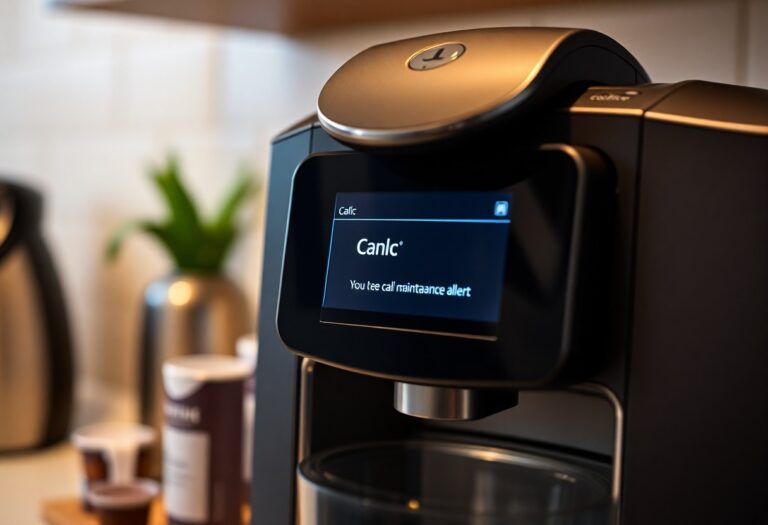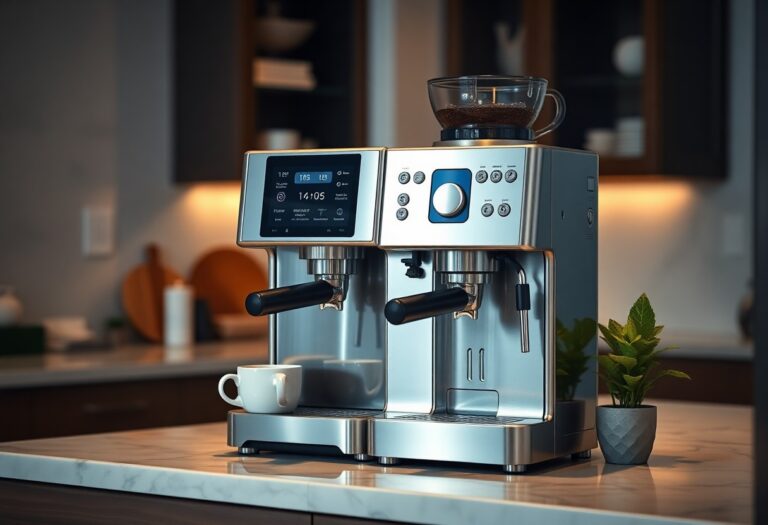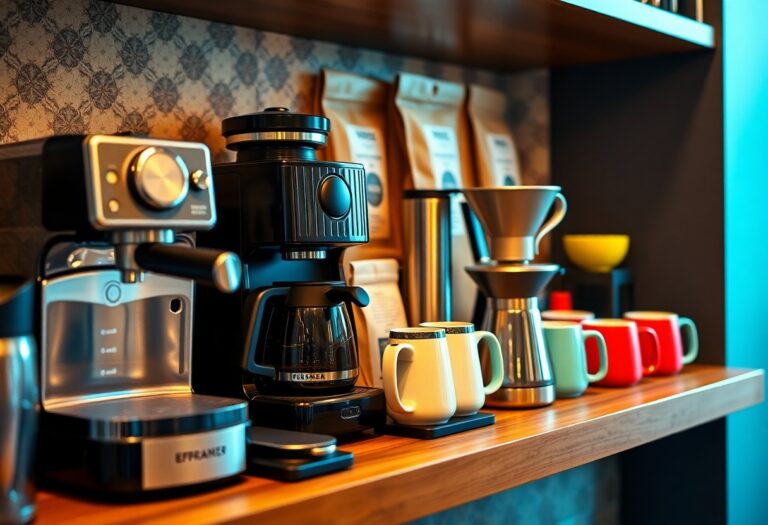What is a Coffee Machine Called – Terminology
Over time, as you initiate on your coffee-making journey, understanding the varied terminology associated with coffee machines becomes crucial. Knowing the different types and functions of these machines not only enhances your brewing experience but also equips you with the knowledge to make informed choices when purchasing or using one. From espresso machines to pod systems, this guide will clarify what each type of coffee machine is called and help you navigate your options effectively, ensuring you enjoy the perfect cup of coffee every time.
Key Takeaways:
- Coffee machines come in various types including drip brewers, espresso machines, single-serve coffee makers, and French presses, each serving a specific brewing method.
- The terminology often varies by region; for example, what is called a “coffee maker” in the U.S. may be referred to as a “filter coffee machine” in other countries.
- Understanding the different components, such as grinders, milk frothers, and brew baskets, can enhance your coffee-making experience.
- Specialized machines like percolators and siphons offer unique brewing techniques that appeal to coffee enthusiasts.
- Common terms associated with coffee machines include “brew time,” “water reservoir,” and “thermal carafe,” which are important for operation and coffee quality.
The Language of Brewing: Essential Terminology
As you explore deeper into the world of coffee, you’ll encounter terminology that can enhance your understanding and appreciation of this beloved beverage. Familiarizing yourself with key terms can transform your experiences from novice to connoisseur. From grind size to extraction time, each term plays a vital role in achieving that perfect cup. Understanding these nuances influences not only your brewing method but also your overall enjoyment of coffee.
Defining the Basics: Coffee Machine Components
Coffee machines consist of various components that work together to brew your favorite drink. Essential elements include the water reservoir, which holds the water needed for brewing, and the brew group, where the coffee grounds and hot water interact. The warming plate keeps your pot warm after brewing, while the grinder ensures your coffee beans are freshly ground to the perfect size. Each part contributes to your machine’s effectiveness and the quality of the coffee you brew.
Beyond the Brew: The Specialized Vocabulary of Baristas
Baristas employ a unique vocabulary that goes beyond basic coffee terminology, enhancing their craft and customer interactions. Terms like latte art, extraction, and pulling shots reflect not just the process but also the artistry involved in coffee preparation. This specialized language can be a gateway to exploring advanced brewing techniques and flavors, allowing you to appreciate the subtleties of different coffee styles. Engaging with this terminology offers insights into the skill and precision that professional baristas bring to the table.
Advanced barista language doesn’t stop at just brewing techniques. Understanding terms like single origin, which refers to coffee sourced from a specific location, or microfoam, a texture of milk perfectly steamed for lattes, can deepen your coffee knowledge. The phrase third wave coffee emphasizes artisanal methods and the coffee’s unique characteristics. By immersing yourself in this specialized vocabulary, you elevate your coffee experiences and create a richer relationship with each cup.
A Deep Dive into Popular Coffee Machine Types
As you navigate the landscape of coffee machines, it’s vital to familiarize yourself with different types that cater to various brewing techniques and preferences. Here’s a quick overview of popular machines:
| Type | Description |
| Espresso Machines | High-pressure devices for a rich coffee shot. |
| Drip Coffee Makers | The standard choice for automatic brewing. |
| French Press | Manual method fostering full flavor extraction. |
| Pour Over | A hands-on technique for precise brewing control. |
| Single-Serve Machines | Convenient option for quick, individual servings. |
The diversity in coffee machines ensures that you can find the right fit for your taste and lifestyle.
Espresso Machines: The Art of High-Pressure Brewing
Espresso machines use pressure to force hot water through finely-ground coffee, resulting in a concentrated shot of coffee known for its rich flavor and velvety crema. Whether you opt for a manual lever or an automatic machine, the imperative characteristic remains: the ability to create intense coffee in seconds.
Drip Coffee Makers: The American Classic in Detail
Drip coffee makers are a staple in American households, valued for their simplicity and efficiency. By pouring water into a reservoir, the machine heats it and drips it over coffee grounds in a filter, allowing fresh coffee to collect in a carafe below.
Often equipped with programmable functions, these machines can brew multiple cups at once, making them convenient for busy mornings. Features like auto shut-off and warming plates ensure that your coffee remains hot and ready to enjoy. With varying brew strengths and designs, you can easily tailor your morning routine to suit your preferences.
French Press and Pour Over: The Manual Brewing Revolution
The French Press allows you to steep your coffee by immersing the grounds in hot water, leading to a rich, full-bodied flavor. You press a plunger through a mesh filter to separate the grounds from the liquid, providing you with a robust cup that retains the imperative oils and flavors.
In contrast, the Pour Over method allows for direct control over the brewing process. You can adjust the speed and technique of pouring hot water over coffee grounds to extract unique flavor notes. Both methods emphasize the importance of water temperature and grind size, allowing you to experiment and perfect your brew.
Unpacking Coffee Machine Features and Specifications
Understanding the features and specifications of coffee machines allows you to tailor your brewing experience. Whether you prefer a simple model or a high-tech espresso machine, knowing the functions—like grind settings, brew strength, and water quality—can greatly influence your coffee journey. Familiarity with these components will empower you to make an informed choice that aligns with your coffee preferences.
Understanding Grind Settings and Brew Strength
Grind settings play a significant role in achieving your desired brew strength. Many machines offer adjustable grind sizes, allowing you to experiment from fine to coarse. A finer grind generally leads to a more concentrated brew, while a coarser grind yields a milder flavor, giving you control over the final cup.
The Role of Water Temperature and Quality
Water temperature greatly affects extraction, with ideal brewing temperatures usually falling between 195°F to 205°F. Using filtered water enhances the taste, minimizing impurities that might alter the flavor profile. Investing in a machine that regulates temperature and promotes high water quality can enhance your cup significantly.
| Water Temperature Range | Recommended Brew Conditions |
|---|---|
| 195°F – 205°F | Optimal extraction of coffee flavors |
| Below 195°F | Under-extraction, resulting in sourness |
| Above 205°F | Over-extraction, leading to bitterness |
Water quality impacts not only flavor but also machine performance. Hard water can lead to scale buildup, which compromises the machine’s efficiency and affects the consistency of your brew. Choosing a coffee machine that incorporates water filtration or softening technology minimizes these issues, ensuring a better tasting cup and longer appliance lifespan.
| Water Quality Factors | Effects on Coffee |
|---|---|
| Hard Water | Scale buildup, off-flavors |
| Filtered Water | Purer taste, improved extraction |
| Purified Water | Neutral profile, minimal minerality |
Programmability and Smart Features in Modern Machines
Modern coffee machines often come equipped with programmability and smart features like scheduling brews and connecting to apps for remote operation. These conveniences mean you can wake up to a fresh cup without the hassle of manually brewing.
Smart coffee machines take user convenience to the next level with features that allow for customization through smartphone apps. You can set brew times, adjust strength, and even control grind size remotely, replicating your favorite café experiences in the comfort of your kitchen. Some models can even learn your brewing habits over time to optimize settings automatically, making every cup just right for you.
The Cultural Significance of Coffee Terminology
The language surrounding coffee is steeped in rich history and cultural nuances, reflecting its global impact. Terms you hear daily like “espresso” or “cappuccino” don’t just describe beverages; they evoke specific traditions and social rituals. In many cultures, coffee serves as a bridge for conversation, connection, and community, illustrating the beverage’s role far beyond a mere caffeine fix. Understanding these terms enhances your appreciation, elevating your coffee experience into a cherished encounter.
How Language Shapes the Coffee Experience
Language informs how you perceive and enjoy coffee. Descriptive terms enhance your sensory experience, allowing for deeper connections to flavors and aromas. Just consider “single origin” versus “blended”; each phrase carries a distinct promise of taste and journey. The way you describe your coffee not only sets the scene for enjoyment but also cultivates a shared appreciation among coffee enthusiasts. This shared language becomes part of the enjoyment and can transform a simple cup into a memorable moment.
Regional Variations in Coffee Terminology
Across different parts of the world, coffee terminology varies, showcasing the rich tapestry of cultural influence. In Italy, for instance, ordering a “caffè” means espresso, while in America, it may refer to regular brewed coffee. These idiosyncratic terms reveal not only local preferences but also the rituals surrounding coffee consumption. Your understanding of these terms can enrich your coffee experiences, enabling you to connect with local customs and practices, whether you’re exploring coffee shops or enjoying a cup at home.
While visiting coffee shops globally, you may encounter terms unique to specific regions. For example, “flat white,” popular in Australia and New Zealand, offers a distinct balance of espresso and steamed milk, highlighting local taste preferences. Conversely, in Sweden, “kafferep” refers to a traditional coffee gathering that celebrates baked goods alongside coffee—showcasing communal aspects that vary from place to place. By appreciating these regional nuances, you can navigate the global coffee landscape with greater confidence and joy.
The Future of Coffee Machines: Trends in Terminology
As coffee culture continues to evolve, so does the language surrounding coffee machines. Emerging trends reflect the increasing sophistication of brewing technology and a growing consumer awareness of sustainability. You may start to hear terms like “smart brewers,” which integrate artificial intelligence, or “zero-waste systems” that emphasize eco-friendly practices. Keep an ear out for these phrases as they signify not only innovation but also a shift toward more responsible consumption in the coffee industry.
Evolving Technology and its Impact on Language
The impact of advancing technology on coffee machines shapes new terminologies that reflect innovation. Terms like “bean-to-cup” have gained prominence, referring to machines that grind fresh beans for every brew, emphasizing convenience and freshness. As automation and connectivity are integrated into devices, phrases like “IoT-enabled coffee makers” have also surfaced, highlighting the connection between coffee enthusiasts and smart technology. This shift not only influences how you perceive coffee brewing but also creates a unique lexicon that defines your experience.
Sustainable Practices and New Terminologies in Brewing
As the push for eco-friendliness spreads, new terms are emerging that capture sustainable practices in coffee brewing. You’ll find concepts like “upcycled coffee,” where waste products are reinvented for new uses, or “direct trade,” which emphasizes ethical sourcing from farmers. These terms are not just buzzwords; they reflect a growing consumer demand for transparency and sustainability in the coffee supply chain.
With increasing awareness of the environmental impact of coffee production, sustainable practices are transforming the terminology landscape. Terms such as “regenerative agriculture” highlight farming techniques that restore soil health and biodiversity, while “carbon-neutral coffee” signifies efforts to offset carbon emissions in production. These definitions resonate among consumers who prioritize sustainability in their purchasing decisions. Keep an eye out for these evolving terms, as they represent a collective shift towards a more environmentally conscious coffee culture that values both quality and responsibility.
To wrap up
With this in mind, understanding the terminology related to coffee machines can greatly enhance your experience as a coffee enthusiast. Knowing the differences between espresso machines, drip coffee makers, and single-serve devices will help you choose the right equipment for your brewing needs. Familiarizing yourself with terms like “grinder,” “brew strength,” and “pressure” will also empower you to make informed decisions, whether you’re purchasing a new machine or perfecting your brewing technique. Embracing this knowledge allows you to elevate your coffee-making skills and enjoy your daily cup even more.
FAQ
Q: What is the general term for a device that brews coffee?
A: The general term for a device that brews coffee is a “coffee maker.” Coffee makers come in various styles and functions, including drip coffee machines, espresso machines, single-serve brewers, and French presses, among others. Each type has its unique characteristics and brewing methods, catering to different preferences for coffee preparation.
Q: What is an espresso machine, and how does it differ from a regular coffee maker?
A: An espresso machine is a specialized type of coffee maker that produces coffee by forcing hot water through finely-ground coffee under high pressure. This method creates a concentrated shot of coffee known as espresso. Unlike regular coffee makers, which typically use a drip or soaking method, espresso machines allow for more control over brewing parameters, resulting in a rich, robust flavor and a creamy layer known as crema on top of the espresso.
Q: What is a French press, and why is it popular among coffee enthusiasts?
A: A French press, also known as a press pot or plunger pot, is a manual coffee brewing device that consists of a cylindrical glass or stainless-steel container and a plunger with a mesh filter. Coffee grounds are steeped in hot water and, after a few minutes, the plunger is pressed down to separate the grounds from the brewed coffee. Its popularity stems from its ability to produce a full-bodied flavor and aroma, as it allows the oils and fine particles from coffee grounds to remain in the brew.
Q: What is a single-serve coffee maker, and how does it work?
A: A single-serve coffee maker, often referred to as a pod coffee maker, is a compact brewing device that prepares one cup of coffee at a time using pre-packaged coffee pods or capsules. Users place a pod in the machine, add water to the reservoir, and start the brewing process. The machine heats the water and forces it through the pod, resulting in a fresh cup of coffee in just a few minutes. This convenience has made single-serve coffee makers widely popular in homes and offices.
Q: What are some other terms associated with coffee machines that users should be aware of?
A: There are several other terms associated with coffee machines, including “drip coffee maker,” which refers to a standard machine that brews coffee by dripping hot water over coffee grounds; “percolator,” a device that cycles boiling water through coffee grounds repeatedly; and “coffee grinder,” which is used to grind whole coffee beans before brewing. Understanding these terms helps users navigate the wide variety of coffee preparation methods available and choose the right one for their needs.







